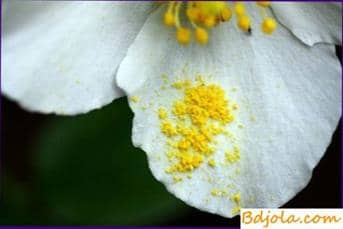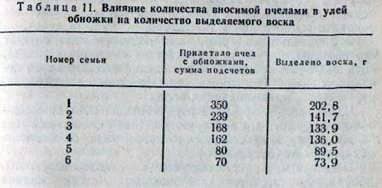
Bees feed on pollen unevenly throughout life. In the early days. after leaving the cell, the bee eats a lot, which causes the midgut to increase greatly: the intestine volume from 6.7 mm3 increases to 22.9 mm3. After switching to flight work, the bee pollen does not consume at all and the volume of its midgut decreases to 8-9 mm3, reaching 6-7 mm3 in old bees. On the 5th day of life, the amount of protein in the body of bees reaches its greatest value.
Bees, in good weather, fly daily and collect pollen, the quantity and quality of which is very difficult to accurately account for. This makes it difficult to determine the digestibility and nutritional value of pollen of different plants. To investigate the digestibility of pollen and pergh by direct feeding to their bees in a hive, only 8 terrain can be found where there are no honey canes and bees can not bring any food into the hive.
To judge the degree of digestibility and nutritional value of pollen and pergi by bees can be by the development of their pharyngeal glands. The fact is that the pharyngeal glands are not completely developed in bees that have just emerged from the cells. They develop only if the bees are fed with a high-grade, well-assimilated protein food. This feature of young bees is based on a method of comparative evaluation of pollen, rejuvenation, perga and other substances. In the cells take 50 grams of young bees (just emerged from the cells). All cells are supplied with 50% sugar syrup. At the same time, the freshly picked up bees are given to the first cell, the second is the test product, and the third is left without protein feed. After 7 and 14 days, the degree of development in the bees of the pharyngeal glands is determined. If the glands of the bees that have received the tested food are developed in the same way as those who have received the pollen, then this indicates a good assimilation of its protein by bees. If the glands developed poorly, as well as in bees in the third cell, then this indicates a complete lack of digestibility of the protein.
In the Institute of Apiculture, the nutritional value of protein feeds was determined by placing bees in the nests from the fall of the test food, placing it in honeycomb cells. In autumn, three equal groups of bee colonies were formed. Families of the first group (control) were supplied with perga; families of the second group did not leave a single cell with perga, but in return they gave the same amount of food tested as in the families of the first group; The families of the third group were not given a protein feed (second control). The bees have been starting to grow brood since the middle of February, and again, before the flowering of the first flowers, they feed on only the food stuffed into the cells of the nest.
If the food tested for nutritional value is equal to perge, then the families of the second group will grow as much brood as the families of the first group. If the feed does not have any nutritional value for the bees, then the families will grow the same number of brood with the families of the third group. With a partial value of feed, experienced families will grow an intermediate amount of brood between the number of it in the first and third groups. This method makes it possible to obtain a characteristic of the nutritional value of the food tested.
The Institute of Apiculture determined the digestion of pollen by bees of seeds, consisting of 500-600 young bees and uterus. The families put sotik with one-day bee larvae. As a result, bees created a need for protein feed (for feeding larvae). On the sides of the sotik with brood, two more honeycombs were placed, the cells of which were given a measured amount of sugar syrup and the protein food tested. The cells were placed in warm casing at a temperature of 13-14 њ C for 5-6 days.
When settling in the hunters, the amount of stool (dry mass) in the hindgut was determined from the sample of 80 to 100 bees. Completing the experiment, again determined the amount of feces and by the difference in its mass, calculated how much stool (in dry form) accumulated over the period of the experiment for all the bees in each cell. Also, the amount of sugar consumed and the protein feed was determined, the amount of brood grown was counted.
In the experiment, various feeds were used, as a result, it was noted that the digestion of their bees by the organism is not the same. So, when feeding the update from willow, the amount of indigestible residues was 29.1%, from hazel – 24.0, s. herbs – 26.3, fresh perga (mixture) – 23.4, with a frozen perghi – 16.6%.
Perga is assimilated by bees somewhat more fully than the rejuvenation, and much more completely than the pollen collected by man without the participation of bees (28-26%). Apparently, by putting the pollen in the update and then updating into the cell, the bees to some extent subject it preliminary; The treatment facilitates the assimilation of it in the intestines of the bee.
A relatively large amount of indigestible residues, which give pollen and pergam, is due to the presence of cellulose in the pollen, which is not digested by bees. In addition, the durable shells of pollen grains impede the full utilization of nutrients. Digestive juice with enzymes first penetrates the pollen grain through the smallest pores in its shell. The shell of the pollen grain is not disturbed. Then, in the posterior part of the middle intestine, the dissolved nutrients through the same pores come out and are absorbed by the walls of the intestine. At the same time pollen nutrients can not be extracted completely, a significant part of them gets into the hindgut and is removed from the body.
Frozen pengu is assimilated by bees more fully than stored at plus temperature. This is due to the fact that the shells of a part of the pollen grains burst in the cold and their contents become more accessible to the digestive enzymes of the bee. However, on a polluted pollen, bees can not grow larvae because of the destruction of its vitamins and other biologically active substances.
All experimental bee families, as noted earlier, had the same number of bees, received the same amount of brood at the beginning of the experiment and were in the same conditions. Therefore, the amount of brood rearing them was directly dependent on the nutritional value of the food received. The most productive food was a mixture of Perga: the bees raised the largest number of broods (11.7-13.5 larvae per 100 bees). A lot of larvae were fed by bees, which received fresh pollen. After annual storage at a temperature of 0-4 њ C, the value of Perga for brood rearing decreased by more than half; After storing Perga in a warm room (20 њ C), the bees almost did not feed the brood. Also, the perga lost its nutritional qualities after storage in the frost (in a non-heated wooden room).
Bees in beehives are always used to feed freshly brought pollen (the most nutritious).
Only in the absence of bees, arriving with the update, they consume the perga, folded into the cells.
Bees-nurses abundantly supply larvae with milk in the first 2-3 days of their development. At this time the larva swims on the stern in the form of a semicircle. Milk for feeding larvae is a translucent light liquid. In the first 2 days it is rich in protein (up to 78% of dry matter), the content of which then decreases with increasing amounts of carbohydrates and fats. From the 3rd day, the bee’s larva begins to receive a gruel-a mixture of honey and pollen, which the bees do not put in the cell, but give it directly to the mouth. Receiving such a nutritious food, the larva rapidly grows. If the larva that emerges from the egg has a mass of 0.08-0.1 mg, then on the 6th day its mass reaches 150 mg (increases by 1500 times).
The main components of milk for feeding larvae are produced in the maxillary (protein part) and in the pharyngeal (carbohydrate part) glands. In young bees, the width of the cells (alveoli) of the pharyngeal gland grows rapidly, reaching a maximum by the 9th-12th day. In the following days, the width of the alveoli decreases and the ability of the gland to release the invertase involved in the processing of nectar sugars begins to increase. The duration of reinforcement of the inverting ability of the gland depends on the time of the season and honey collection. In a weak family, bees spend longer in the feeding stage of larvae than in a strong family, according to which the invertase activity increases later (on the 12th-15th day) than on the weak (on the 25-27th day).
Bees-nurses part of the pollen is transferred to the bee larvae in the form of honey-pollen gruel. The larva of this bee receives an insignificant amount of nitrogenous substances (0.19 mg of nitrogen), ie, one-tenth of all nitrogen in the bee leaving the cell. The remaining nitrogen is fed by the bee larvae with the milk they are fed. Drones and uterus receive all nitrogen from milk (the pollen pulp is not given to them).
The protein content in the body of adult bees varies with age. During the first 5-7 days, the protein content increases rapidly, reaching 5-6 mg due to abundant feeding of pollen. A high level of protein content persists for up to 15 days. After the bee becomes airborne, it does not consume pollen, and the protein content in its body slowly decreases.
Pollen is also necessary for the separation of wax by bees. Still noted that, when receiving only sugar syrup, the bees of wax almost do not emit. In our experience, families of equal mass from young bees and uterus were formed, placed them on honeycomb honeycombs, not containing pergs at all. In each street of the nest left free spaces on top of the honeycombs, which the bees built up with honeycombs. The bees were given the same amount of sugar syrup every day, but they had only the pollen that was brought from the field. It turned out that the amount of wax allocated by these families strictly corresponded to the number of bees introduced by bees: the more pollen the bees brought, the more they extracted wax (Table 11).

In young bees that have not received pollen from the day of emergence from the cells, the waxing glands develop poorly and the wax release decreases in comparison with the normally feeding bees. Adding pollen to the bee’s food in the period until the 9th-11th day of life causes an increase in their waxing glands, after which the pollen does not affect the condition of the gland.
The abundant feeding of bees pollen favorably affects their health. Lack of protein feed significantly shortens their life span and can lead to weakening of families. Nosematosis especially weakens families deprived of protein feed, the most important is the presence of fresh pollen in the fall, when a winter (long-lived) generation of bees is hatched.
Пчелы не берут сироп. Хвойный мед.
Feeding base of beekeeping